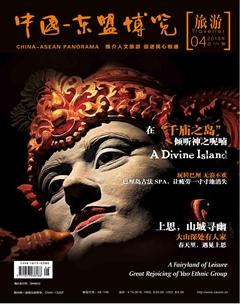Shangsi: An Ecological and Livable County
By Mo Tingting
Located at the coast and border junction at the southwest end of China, Fangchenggang City was built up from Fangcheng County and Shangsi County. Ancestors of Shangsi County lived there since the Neolithic Age, endowing the place with a long history. Shangsi County, one of the joint points of the Economic Circle of southwest China, the Economic Circle of the Pan-Pearl River Delta and the ASEAN Economic Zone, attracts visitors with its extremely beautiful subtropical scenery as well as ecological environment.
Shangsi County, located in the south of Guangxi Zhuang Autonomous Region, on the south part of Shiwan Mountain, borders Qinzhou in the east, Fangcheng Port in the south, Ningming County in the west and Fusui County in the north. Shangsi County boasts a long history, with records of human activities since the Neolithic Age. As early as in the Neolithic Age, ancestors of Shangsi County started to live in this beautiful land, endowing this land with a long history.
Fangchenggang City administers Gangkou District, Fangcheng District, Shangsi County and Dongxing City. During the Qin Dynasty (221 BC-207 BC), Fangchenggang belonged to Xiangjun Prefecture. The name of “Fangcheng” firstly appeared in the history in the Song Dynasty (960-1279). Later in the Qing Dynasty (1644-1911), Fangcheng County was set up under the control of Guangdong government. Fangcheng City was an administrative division of Guangxi from 1951 to June 1955. It reverted to Guangdong Province from July 1955 to July 1965. Fangchenggang District, together with Beihai City, was among the 14 open coastal cities approved by the State Council in 1984. In 1985, Fangchenggang District was formed in Guangxi and later in 1993 it was changed into a prefecture-level city, including the ethnic autonomous counties, Fangchenggang District, as well as Shangsi County.
For anyone who wants to see the best of Chinas southwest, Fangchenggangs Shangsi County is a must-visit. As a small county, Shangsi County has a lot of advantages such as the natural oxygen with spectacular scenery, primitive forest and pleasant air. Shangsi County belongs to the subtropical monsoon climate zone. In Shangsi County, the treasure of nature has gone through many changes, reflecting major phases of the earth evolution including geomorphic evolution, geological form and natural geographical features. It is precise because of those geological movements that we can easily find various forms of rocks which look like monkeys, swallows and pandas.
Have you ever had an interest in unsolved mysteries since your childhood? If you come to Shangsi County, you will not feel disappointed. The tales of python, the world-famous Shiwan Mountain as well as the local primitive custom have endowed this land with profound cultural connotation and characteristics. With a long history of human civilization supported by archaeological evidence, Shangsi County has nurtured people for generations. Yao ethnic group dwelling in the mountains are good at both singing and dancing. Shangsi County is like a goblet of mellow wine. Once you taste it, you will be as drunk as a lord.
Shangsi County owns plenty of special products. The most well-known ones are “five reds and five goldens”. The “five reds” refer to red sweet potatoes, red peanuts, red wax apples, red pitayas and red star anises. The “five goldens” refer to golden camellias, golden tangerines, golden sticky rice, golden cinnamons and golden pineapples. At present, the planting area is 1.45 million mu (96,666 hectares), with an output of over 212,000 tons.
Apart from being a land of plenty, Shangsi County also is noted as the “Longevity County in China”. A folk song in Shangsi County, Fangchenggang City has the words that “People in their 80s are not old, people in their 90s can be found everywhere and people in their 100s are still in good health”.
With regard to the environment, situated in the north of Shangsi County, the Shiwan Mountain has the charm of majesty, uniqueness, tranquility, elegance, wildness and primitiveness. Its approved by the United Nations Environment Programme (UNEP) to be the largest Global Environment Facility (GEF) international forest demo area in China and the third largest GEF international forest demo area in the world. Shiwan Mountain can serve as transfer areas for the migrant birds to spend winter for it has the function of wind prevention, soil protection and siltation accretion, purification of water and the air. The forest covers 254,000 hectares, of which more than 40,000 hectares is virgin forest. In 2011, the city was awarded as a famous city with “Natural Oxygen Bars in China” by China Ecological Society. There are more than 1,500 species of plants in this ecological system and 40 of them are listed among key national preserved species. Animals of every size can hide easily in such places and many are recorded.
The egret is a kind of bird that can be easily found in Shangsi County. There are about 300,000 egrets of 12 species in Shangsi County. In July, 2011, the city was honored as “Home of Egrets of China” by China Wildlife Conservation Association. It is the only place in China endowed with the honor at present.
Shangsi County has the most varieties of golden camellia genes in the world. From December to March the next year, golden camellia flowers blossom and cover the whole area. Shangsi Countys golden camellia is of rare species which can be dated back over 170 million years ago. Over 95% of the golden camellias in the world grow in Shangsi County, making the county the largest natural conservation area of golden camarillas. In 2011, it was honored as the “Land of Golden Camellia in China”.

